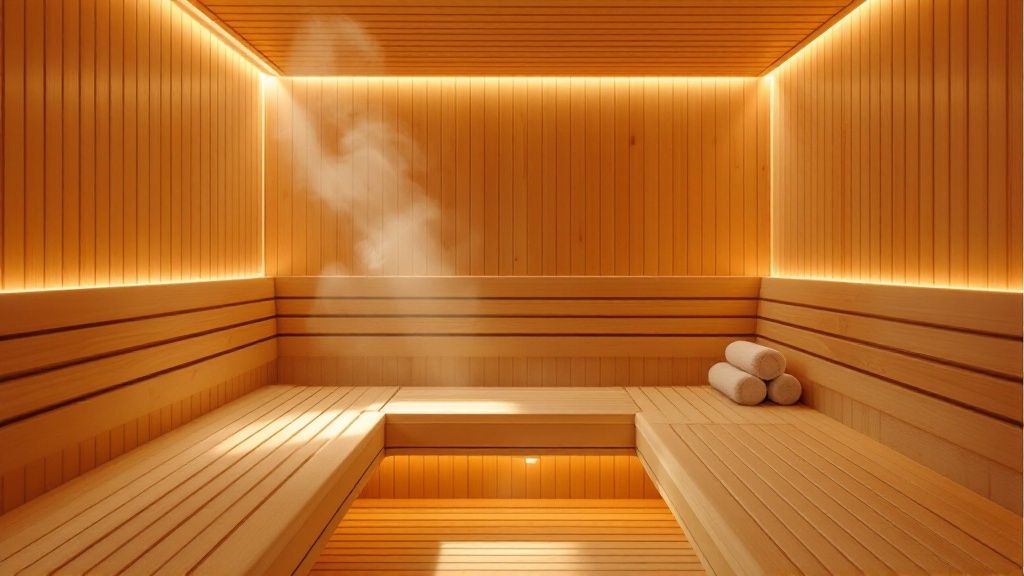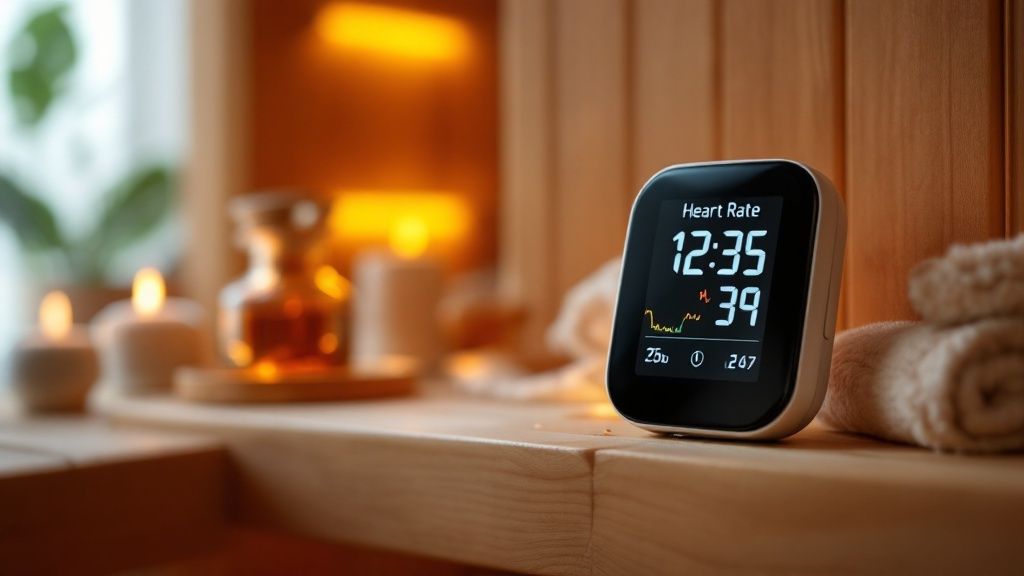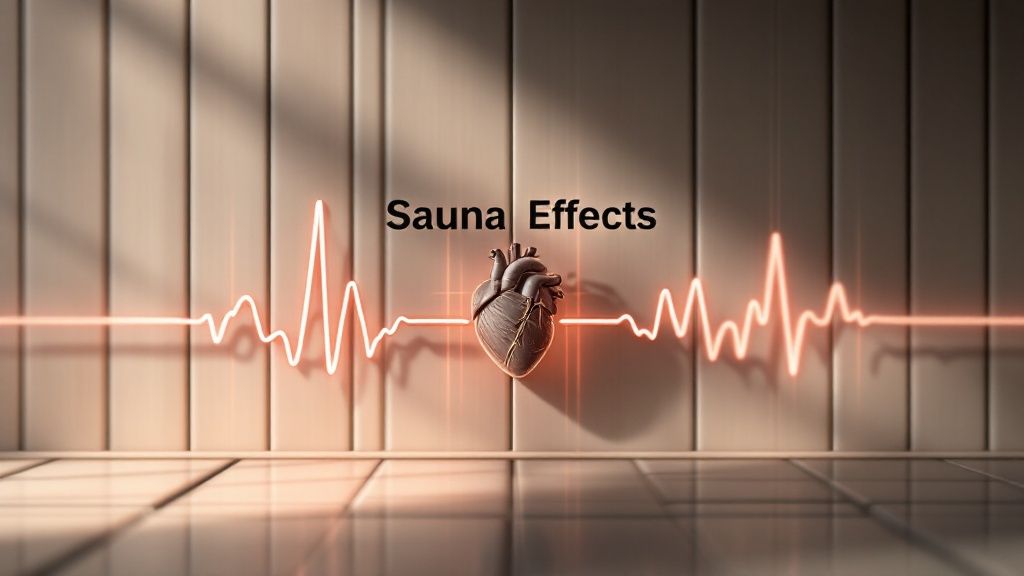Sauna Heart Rate: Master Your Cardiovascular Health Journey
- Sauna Tracker

- Apr 8
- 11 min read
The Science Behind Your Sauna Heart Rate Response

Stepping into a sauna sets off a chain reaction within your body, especially in your cardiovascular system. One of the first things you'll notice is a rise in your heart rate. This is a perfectly normal response to the increased temperature. But what exactly causes this elevation?
Understanding the Cardiovascular Response
The heat from the sauna causes vasodilation, which is the widening of your blood vessels. This is similar to the effect of moderate exercise. This widening decreases peripheral resistance, making it easier for blood to flow. Your heart rate then increases to compensate for this lower resistance and maintain proper blood pressure and circulation. The increased blood flow brings more oxygen and nutrients throughout your body, which contributes to the numerous health benefits of sauna use.
In addition to vasodilation, your body activates its internal cooling system, known as thermoregulation, to manage the excess heat. Sweating is the most visible sign of this, but internally, your heart plays a vital role. The increased heart rate pushes blood closer to the skin’s surface, allowing heat to escape through evaporation. This process further contributes to the rise in your heart rate.
Saunas have demonstrated positive impacts on heart health, including influencing heart rate during sessions. Studies show that heart rate typically rises during sauna use, averaging around 120 beats per minute (bpm). This is comparable to the heart rate achieved during moderate exercise. This elevated heart rate is one of the reasons saunas can improve cardiovascular health, by boosting circulatory responses. A study from the University of Eastern Finland observed these effects in 102 participants during a single 30-minute sauna session. These results suggest that regular sauna bathing, especially four to seven times a week, may contribute to lower cardiovascular mortality rates, as seen in long-term studies. It's important to remember, however, that saunas are not a substitute for regular exercise but can complement a workout routine for improved heart health. Learn more about the benefits of saunas here. You might be interested in: Our blog categories.
Interpreting Your Heart Rate Fluctuations
While an increase in heart rate is normal during a sauna session, the degree of increase can differ based on individual factors such as age, fitness level, and overall health. Keeping track of your heart rate in the sauna can offer valuable information about how your body handles heat stress. A consistently lower heart rate in later sauna sessions, for instance, could indicate improved cardiovascular fitness and heat adaptation. On the other hand, an excessively high or irregular heart rate might suggest a need to adjust the sauna's temperature or the duration of your sessions. Understanding these variations allows you to personalize your sauna experience for optimal benefits and safety.
Unlocking Heart Rate Variability Benefits Through Sauna

Beyond simply tracking your sauna heart rate, understanding Heart Rate Variability (HRV) provides valuable insights into your cardiovascular health. HRV measures the subtle time differences between heartbeats. This variation reflects the balance between your sympathetic and parasympathetic nervous systems. A higher HRV is generally associated with better stress resilience and cardiovascular well-being.
How Sauna Impacts HRV
Sauna sessions induce a specific HRV fluctuation pattern. Initially, the heat activates your sympathetic nervous system, causing a temporary decrease in HRV. This is similar to the body's response during exercise. As you cool down, the parasympathetic nervous system takes over, resulting in a beneficial increase in HRV. This parasympathetic activation is essential for stress recovery and long-term cardiovascular health.
Research on sauna bathing and HRV shows compelling results. A study of 93 participants with cardiovascular risk factors demonstrated increased HRV during post-sauna recovery. This suggests enhanced parasympathetic activity and reduced sympathetic activity—both positive signs for heart health. Heart rate initially increased during the sauna session but returned to lower resting rates after recovery. Learn more about the connection between sauna and HRV.
Optimizing HRV Through Sauna Use
To maximize the HRV benefits from sauna use, consider the following:
Consistency is Key: Regular sauna sessions, rather than occasional ones, are more likely to produce lasting HRV improvements.
Monitor and Adjust: Listen to your body. Adjust the temperature or duration if you experience excessive stress or fatigue.
Prioritize Recovery: The cool-down period after a sauna session is essential for the parasympathetic rebound and HRV increase. Allow ample time for relaxation.
Hydration Matters: Staying hydrated is important for cardiovascular function and the body's response to heat stress, indirectly benefiting HRV.
Emerging research continues to explore the relationship between environmental factors and hormone levels, such as the connection between sunlight and hormone levels. By understanding how sauna use affects HRV, you can tailor your sauna routine to boost your cardiovascular health and overall well-being.
The Remarkable Long-Term Heart Benefits of Sauna Sessions

While a single sauna session can offer immediate benefits like a faster heart rate and better circulation, the long-term effects of regular sauna use are truly impressive. Making sauna bathing a regular part of your routine can significantly improve your cardiovascular health. This means that consistent heat exposure and the body's responses can contribute to a healthier heart over time. Let's explore the science behind these benefits.
The Dose-Response Relationship: More Sauna, More Benefits
Many studies highlight a strong connection between sauna frequency and a reduced risk of heart disease. This dose-response relationship means that using a sauna more often leads to greater protective benefits for your heart. Frequent sauna use has been linked to a substantial reduction in cardiovascular mortality rates.
A pivotal study from the University of Eastern Finland followed over 2,300 men for 20 years. To illustrate the findings, let's take a look at the following table:
Sauna Frequency and Cardiovascular Mortality
This table shows the relationship between sauna bathing frequency and cardiovascular mortality rates based on the University of Eastern Finland's 20-year study.
Sauna Frequency | Mortality Rate | Risk Reduction (Compared to Once a Week) |
|---|---|---|
Once a week | 49% | - |
2-3 times a week | 38% | 22% |
4-7 times a week | 31% | 37% |
The table clearly shows how increased sauna use correlates with lower mortality. Men who enjoyed saunas four to seven times a week experienced the greatest reduction in risk.
These long-term benefits likely come from sauna-induced improvements in blood pressure, vascular function, and stress reduction. These factors all contribute to lower risks of heart-related deaths. The mechanisms at play include better nitric oxide production, which improves vascular function, and increased levels of heat shock proteins, which protect against cellular damage. You can discover more insights about sauna use and longevity.
Physiological Adaptations: How Sauna Strengthens Your Heart
Regular sauna use triggers several positive physiological changes that contribute to long-term cardiovascular health.
Improved Vascular Elasticity: Repeated heat exposure makes blood vessels more flexible and responsive. This improves blood flow and reduces strain on the heart.
Enhanced Nitric Oxide Production: Sauna bathing stimulates the production of nitric oxide, a molecule that relaxes blood vessels and lowers blood pressure.
Increased Heat Shock Proteins: The heat stress from sauna sessions prompts the production of heat shock proteins, which protect heart cells from damage and boost their recovery from stress.
These adaptations, along with the general stress-reducing effects of sauna, work together to protect your heart health in the long run. You can find additional information in our blog posts.
Real-World Benefits: Lowering Your Risk
The physiological changes from regular sauna use translate into real cardiovascular improvements. Studies have linked frequent sauna bathing to:
Reduced Heart Attack Risk: Improved vascular function and blood pressure regulation contribute to a lower chance of heart attacks.
Lower Stroke Incidence: Better blood flow and reduced inflammation can decrease the risk of strokes.
Improved Blood Pressure Profiles: Consistent sauna use can help lower both systolic and diastolic blood pressure, further reducing strain on the cardiovascular system.
These long-term benefits show that integrating regular sauna use into a healthy lifestyle can significantly benefit your heart health for years to come.
The Exercise-Sauna Synergy for Optimal Heart Rate Benefits

Many people enjoy both exercise and sauna bathing for their individual health advantages. Combining these two practices, however, can create a powerful synergy that boosts their positive impact on heart health. This combined approach offers a more well-rounded strategy for cardiovascular well-being. This means that pairing these activities may offer greater benefits than doing them separately.
Understanding the Combined Effects
Combining exercise and sauna use offers unique advantages for cardiovascular health. Exercise strengthens the heart muscle and improves circulation. Sauna use further enhances these benefits through vasodilation, the widening of blood vessels, which helps reduce blood pressure.
Studies show that those who combine sauna sessions with regular exercise see greater improvements in blood pressure and total cholesterol levels compared to those who only exercise. Adding sauna to your routine can provide an added boost to your heart health efforts.
Furthermore, the combination appears to have additional heart health benefits. Research suggests that using a sauna after exercise can further enhance improvements in blood pressure and total cholesterol levels compared to exercise alone. For instance, studies indicate combining regular exercise with sauna sessions leads to better cardiovascular respiratory fitness, reducing the risk of heart disease. Sauna bathing also increases good cholesterol (HDL) levels and reduces stress, further contributing to improved heart health. This synergistic effect likely occurs because sauna-induced increases in heart rate and circulation mimic some of the benefits of exercise, while also aiding in relaxation and stress reduction. Learn more about sauna and heart health here.
Optimizing Your Routine: Sauna Before or After Exercise?
When you choose to have your sauna session in relation to your workout can impact the specific benefits you experience. While both pre- and post-exercise sauna use have their advantages, there are key differences to consider. Choosing the right timing helps maximize the synergy.
Sauna Before Exercise: Using the sauna before working out can improve muscle flexibility and increase blood flow, potentially enhancing performance. Remember to rehydrate thoroughly before exercising to compensate for fluid loss in the sauna.
Sauna After Exercise: A post-workout sauna session can help with muscle recovery by lessening muscle soreness and inflammation. It can also amplify the cardiovascular benefits of exercise by further elevating heart rate and promoting deeper relaxation.
Creating a Personalized Exercise-Sauna Protocol
To maximize the heart rate benefits of combining exercise and sauna, consider these best practices:
Listen to Your Body: Pay attention to how you're feeling. If you experience lightheadedness or overheating, reduce the intensity of your workout or shorten your sauna session.
Stay Hydrated: Hydration is crucial. Drink plenty of water before, during, and after exercise and sauna sessions.
Consult with Professionals: If you have any underlying health conditions, talk to your doctor or a qualified healthcare professional before combining exercise and sauna use. They can help you create a safe and effective plan.
Gradual Progression: Gradually increase the intensity and duration of your exercise and sauna sessions as your fitness level and heat tolerance improve.
By following these guidelines and personalizing your approach, you can safely and effectively utilize the synergy of exercise and sauna for optimal heart rate benefits and overall cardiovascular health.
Sauna Heart Rate Safety: Protecting Your Cardiovascular Health
While sauna use offers many cardiovascular benefits, prioritizing safety is paramount, especially for those with pre-existing heart conditions. Understanding responsible sauna practices is key to protecting your heart health. This section offers evidence-based guidelines for safe sauna use.
Understanding Safe Heart Rate Ranges During Sauna Use
Sauna bathing elevates heart rate much like moderate exercise. Knowing your safe limits, however, is crucial. This involves understanding how your heart rate responds to the heat and recognizing potential warning signs. An average increase to approximately 120 bpm is typical, but this varies based on individual factors such as age and fitness level. For instance, a regular exerciser might see a smaller heart rate increase than someone less active.
Monitoring Your Heart Rate and Recognizing Warning Signs
Actively monitoring your heart rate during sauna sessions is essential. You can manually check your pulse or use a heart rate monitor. Staying within a safe range and recognizing any concerning changes is vital. Be alert to these warning signs:
Dizziness or Lightheadedness: These could indicate low blood pressure or dehydration.
Chest Pain or Discomfort: This is a serious symptom requiring immediate medical attention.
Heart Palpitations or Irregular Heartbeat: This could indicate an arrhythmia and warrants caution.
Excessive Shortness of Breath: This may suggest your cardiovascular system is struggling with the heat stress.
If you experience any of these, leave the sauna immediately and cool down slowly.
Hydration: A Key Component of Sauna Heart Rate Safety
Proper hydration is crucial for maintaining cardiovascular stability during sauna use. Dehydration can worsen heart rate increases and lead to dangerous complications. Drink plenty of water before, during, and after your sauna session. This helps regulate body temperature and maintain healthy blood pressure. For example, drink a glass of water before entering, take small sips during if needed, and rehydrate thoroughly afterward.
Special Considerations for Specific Cardiovascular Conditions
Individuals with conditions like hypertension, arrhythmias, or a history of cardiac events need extra caution. Consult your doctor before using a sauna to ensure its safety for your specific condition. Your doctor can offer personalized guidance based on your health history. You can find more information on our Sauna Tracker's sitemap.
Hypertension: Sauna use can temporarily lower blood pressure, but it can also cause fluctuations. Careful monitoring is essential.
Arrhythmias: The heat can sometimes trigger irregular heartbeats. Discuss sauna use with a cardiologist to assess potential risks.
Previous Cardiac Events: If you've had a heart attack or other cardiac event, medical clearance is essential before sauna use.
To help guide you, consult the following table for recommendations:
To help you understand safe heart rate practices in the sauna, review the following guidelines based on your health profile:
Sauna Heart Rate Guidelines by Health Profile
Health Profile | Max Heart Rate | Recommended Duration | Special Considerations |
|---|---|---|---|
Healthy Adult | Up to 120 bpm | 15-20 minutes | Monitor for any warning signs |
Beginner | Lower end of target range | 5-10 minutes | Gradually increase duration as tolerated |
Active Individual | May tolerate higher heart rate | Up to 20 minutes | Listen to your body, adjust duration as needed |
Hypertension | Monitor carefully, avoid exceeding comfortable range | Start with shorter sessions | Consult with doctor before use |
Arrhythmias | Avoid exceeding comfortable range | Shorter sessions, monitor closely | Consult with cardiologist |
Previous Cardiac Events | Consult with doctor before use | Doctor-recommended duration | Close monitoring is crucial |
This table provides general guidelines; always consult your doctor for personalized advice.
Communicating with Healthcare Providers About Sauna Therapy
Openly discuss your sauna habits with your healthcare providers. This enables them to monitor your cardiovascular health effectively and adjust medications if needed. It ensures they have a complete picture of your health practices and can provide a safe and effective plan. This approach helps you leverage sauna benefits safely within your overall health management.
Master Protocols: Optimizing Sauna Heart Rate Benefits
Turning general sauna guidelines into a personalized plan involves understanding how to adjust your sauna heart rate for the best cardiovascular results. This section offers specific sauna routines, or protocols, designed to maximize those benefits. These protocols include recommendations for temperature, session length, cooling breaks, and how often you use the sauna each week, all designed to create the best heart rate responses for your personal goals.
Traditional Finnish Sauna vs. Contemporary Methods
The traditional Finnish sauna often involves cycles of dry heat followed by short, cold plunges. This method significantly impacts heart rate, causing it to rise quickly in the heat and drop sharply during the cold plunge. This trains your body to adapt quickly to temperature changes. Contemporary methods may use more gradual temperature changes and longer cooling-off periods, leading to a slower heart rate response. The best approach depends on your fitness and comfort level. Beginners might prefer a gentler, more gradual approach.
Progressive Challenge and Heart Rate Adaptation
As your body adjusts to the sauna's heat, your heart rate will respond differently. At first, you might notice a larger heart rate increase with each session. With consistent sauna use, your heart will become more efficient at handling the heat stress. This lets you progressively challenge your cardiovascular system by slowly increasing the temperature or length of your sauna sessions to keep getting benefits as your tolerance grows.
Integrating Heart Rate Monitoring Technology
Monitoring your heart rate in the sauna can give you valuable data and help you fine-tune your sessions. Wearable technology, like heart rate monitors, provides real-time data during your session. This data helps you adjust the temperature and duration on the spot, maximizing the benefits and staying safe. By watching trends in your heart rate response, you can track your progress and find the most effective sauna protocol for you.
Infrared vs. Traditional Saunas and Heart Rate
Infrared saunas and traditional saunas create heat differently, affecting heart rate responses. Traditional saunas heat the air around you, while infrared saunas use light waves to heat your body directly. This difference leads to varying heart rate patterns. Some research suggests infrared saunas might cause a greater heart rate increase at lower temperatures than traditional saunas. This could be good for those sensitive to high heat. More research is needed to fully compare their long-term cardiovascular effects. The choice between the two often comes down to personal preference.
Tailoring Sauna Protocols to Specific Goals
Here’s an example protocol showing how to personalize your sauna sessions based on your goals:
Beginner Protocol (Cardiovascular Health Introduction):
Temperature: 150-160°F (65-71°C)
Duration: 10-15 minutes
Cooling: 5-10 minutes at room temperature
Frequency: 2-3 times per week
Intermediate Protocol (Enhancing Cardiovascular Fitness):
Temperature: 170-180°F (77-82°C)
Duration: 15-20 minutes
Cooling: Brief cool shower or cool-down period
Frequency: 3-4 times per week
Advanced Protocol (Maximize Cardiovascular Adaptation):
Temperature: 180-190°F (82-88°C)
Duration: 20-25 minutes (with experience)
Cooling: Cold plunge or cool shower
Frequency: 4-7 times per week (with careful monitoring)
Ready to improve your sauna experience and optimize your cardiovascular health? Download Sauna Tracker today and start a personalized sauna journey! Sauna Tracker: Your Personal Sauna Companion

.png)
